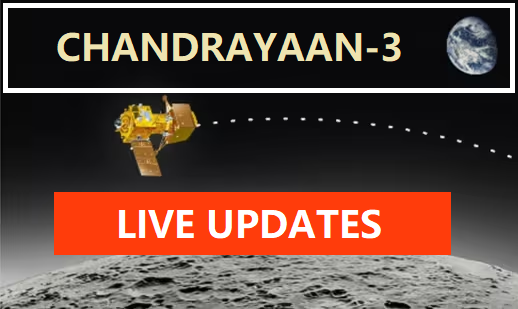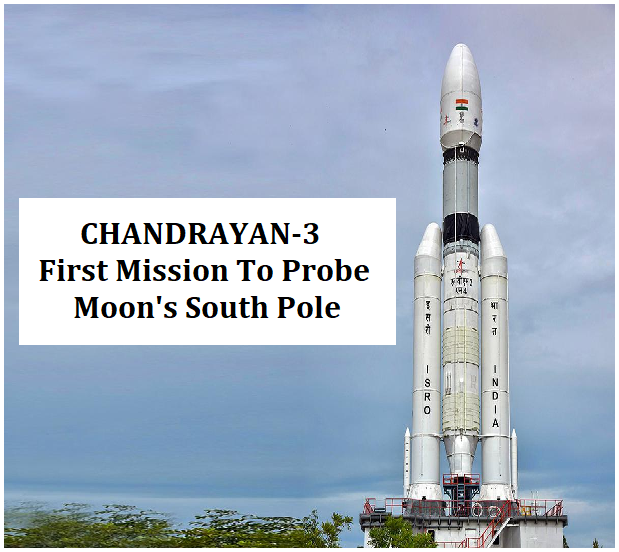Live Updates of Chandrayan-3
Latest updates on Chandrayan-3:
India's Chandrayaan-3, which was launched on July 14 and has spent nearly a month travelling from Earth, is scheduled to touch down on the surface of the Moon on Wednesday. Chandrayaan-2's orbiter and Chandrayaan-3's lander module can now communicate with one another, according to recent information from ISRO. The lander from Chandrayaan-3 is scheduled to make a soft landing on the moon at 6:04 pm on August 23, 2023. From Wednesday at 5:20 pm, anyone may watch the landing live online. ISRO hopes that this accomplishment would pique young people's interest in space travel.
Where can you watch the Chandrayaan-3's Live Landing?
On the official website, you may follow Chandrayaan-3 in real time. You may get up-to-date information about Chandrayaan-3's landing and status there. You may also follow Chandrayaa-3's live monitoring videos on Youtube to get updates on the current event. You may also follow them on Facebook and watch them live on the DD National TV Channel to remain updated. You may follow the construction of Chandrayaan-3 in real time and learn more about this significant event with the use of these resources.
Watch Live Here|
A new story in a few hours
In 2019, ISRO's Chandrayaan-2 mission crashed during soft landing. In the same year, Israel failed to land the Beth Lander on the moon. And in 2003, the mission undertaken by the Japanese private space company-I Space failed at the last minute. Recently, the Russian Luna 25 also crashed. Now, if Chandrayaan-3 is successful, India will become the 4th country after Soviet, USA and China to achieve this feat.
What if Chandrayaan-3 does not land today?
ISRO has a fallback strategy in place for August 27 in case the August 23 landing of Chandrayaan-3 is not feasible. Two hours prior to the scheduled landing time, ISRO scientists will determine if it is safe to land based on the lander's condition and the lunar environment. August 23 if all goes according to the plan ; August 27 if not. It will land somewhere between 5:00 to 6:30 o'clock. The Vikram Lander has specialized cameras and equipment for a safe and secure landing. The lander will use a variety of equipment to investigate the Moon's surface if the landing is successful.
చంద్రయాన్-3ని ఆగస్టు 23న ల్యాండింగ్ చేయడం సాధ్యపడకపోతే ఆగస్టు 27న ఫాల్బ్యాక్ స్ట్రాటజీని ఇస్రో సిద్ధం చేసింది. నిర్ణీత ల్యాండింగ్ సమయానికి రెండు గంటల ముందు, ల్యాండర్ పరిస్థితి మరియు చంద్ర వాతావరణం ఆధారంగా ల్యాండ్ చేయడం సురక్షితం కాదా అని ఇస్రో శాస్త్రవేత్తలు నిర్ణయిస్తారు. అన్నీ అనుకున్నట్లు జరిగితే ఆగస్టు 23; కాకపోతే ఆగస్ట్ 27. ఇది 5:30 మరియు 6:30 గంటల మధ్య ఎక్కడో ల్యాండ్ అవుతుంది. విక్రమ్ ల్యాండర్లో సురక్షితమైన ల్యాండింగ్ కోసం ప్రత్యేకమైన కెమెరాలు మరియు పరికరాలు ఉన్నాయి. ల్యాండింగ్ విజయవంతమైతే చంద్రుని ఉపరితలం మరియు పరిసరాలను పరిశోధించడానికి ల్యాండర్ అనేక రకాల పరికరాలను ఉపయోగిస్తుంది.
Chandrayaan-3 Mission : When and What happened?
- July 14 - Chandrayaan-3 journey started from Sriharikota. Orbit step by step
- Raised scientists 8 August 1-Moon orbit
- August 5- Entry into lunar orbit
- August 6, 9, 14, 16- Orbit reduction maneuvers
- August 17- From the propulsion module A detached lander
- August 18- First process of speed reduction
- August 20- Second process of speed reduction
Why ISRO wanted to land Chandrayaan-3 onto the moon?
With the launch of Chandrayaan-3 carried out at a cost of 615 crores, it is possible to know the secrets of the birth of the moon. As part of this, along with the rover that will land on the surface of the moon, the lander will also have to perform many experiments and achieve the goals set by ISRO. Exploration of lunar surface, atmosphere, availability of water, observation of minerals, availability of elements are important in this. They also take photos and 3D mapping of the lunar surface.
The goal is to launch a manned Chandrayaan-3
ISRO's Chandrayaan mission was launched with the aim of exploring the possibility of human life on the moon. The information sent by Chandrayaan-3 will be crucial for the next experiments. According to this information, Chandrayaan-4,5,6 will be carried out by ISRO. ISRO's target is to send astronauts to the moon by Chandrayaan 10 or 11 with the information coming from a series of experiments.
Why Chandrayan-3 wants to be the First Mission To Probe Moon's South Pole?
The launch of the Chandrayaan-3 mission represents the continuation of the world's first mission, which aims to make a soft landing near the Moon's south pole. The Chandrayaan-2 mission, launched in 2019, attempted to accomplish the same but failed to land softly on the Moon.
According to ISRO authorities, India's Chandrayaan-3 would reach lunar orbit around a month after launch. On August 23, its lander Vikram and rover Pragyaan will attempt to touchdown on the Moon.
The landing spot for Chandrayaan-3 is similar to that of Chandrayaan-2, which is near the Moon's south pole at 70 degrees latitude. If all goes as planned, Chandrayaan-3 will be the world's first mission to soft-land near the Moon's south pole.
Because it is much simpler to land a spacecraft near the Moon's equator, most Moon missions touchdown distant from the poles. The climate and terrain in that area make it simpler to operate electronics. The polar regions are difficult to navigate since many areas are completely dark at all times and get no sunshine, with temperatures reaching -230 degrees Celsius.
These circumstances, along with the occurrence of enormous craters spanning hundreds of miles, can make instrument functioning challenging.
ISRO scientists aim to investigate the Moon's polar regions because deep craters in this region may contain ice molecules. The Chandrayaan-1 mission also indicated this.
Furthermore, because freezing temperatures keep everything confined, the circumstances on this portion of the Moon may preserve information about the early solar system and the history of Earth.













